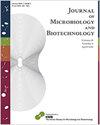探索调控朝鲜芒柄伞 HL12 中左旋果寡糖生产的左旋琥珀酸酶操作子
IF 3.1
4区 生物学
Q3 BIOTECHNOLOGY & APPLIED MICROBIOLOGY
引用次数: 0
摘要
利凡生物聚合物和利凡型果寡糖(L-FOSs)是β-2,6-连接果聚糖,已被用作非消化性膳食纤维和益生寡糖,在食品和药用化妆品中得到广泛应用。在这项研究中,我们探讨了负责在韩国藜麦 HL12 中生产利凡和 lL-FOSs 的操作子。本研究首次从基因组学角度探讨了该细菌对蔗糖的利用以及利凡的生物合成途径。在序列注释方面,在菌株HL12的基因组中发现了负责β-2,6-连接果聚糖的假定左旋蔗糖酶操作子,该操作子包括属于GH68的sacB左旋蔗糖酶基因,该基因与属于GH32的levB内切蔗糖酶基因相邻。重要的是,与利凡生物合成途径相关的糖类拟通过 3 种运输系统进行运输,包括多种 ABC 糖和葡萄糖/H+ 转运体,以及葡萄糖和果糖特异性 PTS 系统。根据产物图谱分析,HL12 菌株在高浓度蔗糖(300 克/升)条件下生产利凡的效率很高,48 小时培养后的最高产量为 127 克/升(相当于消耗蔗糖 55% 的转化率),同时还生产出短链 L-FOS(DP3-5)和长链 L-FOS,且各自的粒径均大于 DP6。这些发现凸显了 P. koreensis HL12 作为全细胞生物催化剂生产利凡和 L-FOSs 的潜力,并强调了它在将糖转化为高附加值产品以用于各种商业和工业应用方面的新颖性。本文章由计算机程序翻译,如有差异,请以英文原文为准。
Exploring Levansucrase Operon Regulating Levan-Type Fructooligosaccharides Production in Priestia koreensis HL12.
Levan biopolymer and levan-type fructooligosaccharides (L-FOSs) are β-2,6-linked fructans that have been used as non-digestible dietary fiber and prebiotic oligosaccharides in food and cosmeceutical applications. In this study, we explore the operon responsible for levan and lL-FOSs production in Priestia koreensis HL12. Presented is the first genomic perspective on sucrose utilization and the levan biosynthesis pathway in this bacterium. Regarding sequence annotation, the putative levansucrase operon responsible for β-2,6-linked fructan was identified in the genome of strain HL12, and comprises sacB levansucrase gene belonging to GH68, located adjacent to levB endo-levanase gene, which belongs to GH32. Importantly, sugars related with the levan biosynthesis pathway are proposed to be transported via 3 types of transportation systems, including multiple ABCSugar and glucose/H+ transporters, as well as glucoseand fructose-specific PTS systems. Based on product profile analysis, the HL12 strain exhibited high efficiency in levan production from high sucrose concentration (300 g/l), achieving the highest yield of 127 g/l (equivalent to 55% conversion based on sucrose consumption), together with short-chain L-FOSs (DP3-5) and long-chain L-FOSs with respective size larger than DP6 after 48 h incubation. These findings highlight the potential of P. koreensis HL12 as a whole-cell biocatalyst for producing levan and L-FOSs, and underscore its novelty in converting sugars into high-value-added products for diverse commercial and industrial applications.
求助全文
通过发布文献求助,成功后即可免费获取论文全文。
去求助
来源期刊

Journal of microbiology and biotechnology
BIOTECHNOLOGY & APPLIED MICROBIOLOGY-MICROBIOLOGY
CiteScore
5.50
自引率
3.60%
发文量
151
审稿时长
2 months
期刊介绍:
The Journal of Microbiology and Biotechnology (JMB) is a monthly international journal devoted to the advancement and dissemination of scientific knowledge pertaining to microbiology, biotechnology, and related academic disciplines. It covers various scientific and technological aspects of Molecular and Cellular Microbiology, Environmental Microbiology and Biotechnology, Food Biotechnology, and Biotechnology and Bioengineering (subcategories are listed below). Launched in March 1991, the JMB is published by the Korean Society for Microbiology and Biotechnology (KMB) and distributed worldwide.
 求助内容:
求助内容: 应助结果提醒方式:
应助结果提醒方式:


